2025.07.05
Shun: Discovering Seasons of Japan Through Kaiseki Cuisine
By Chef Yuuki Tanaka, owner of Ise Sueyoshi — Tripadvisor Best of the Best: Japan #1, World #12.(source).
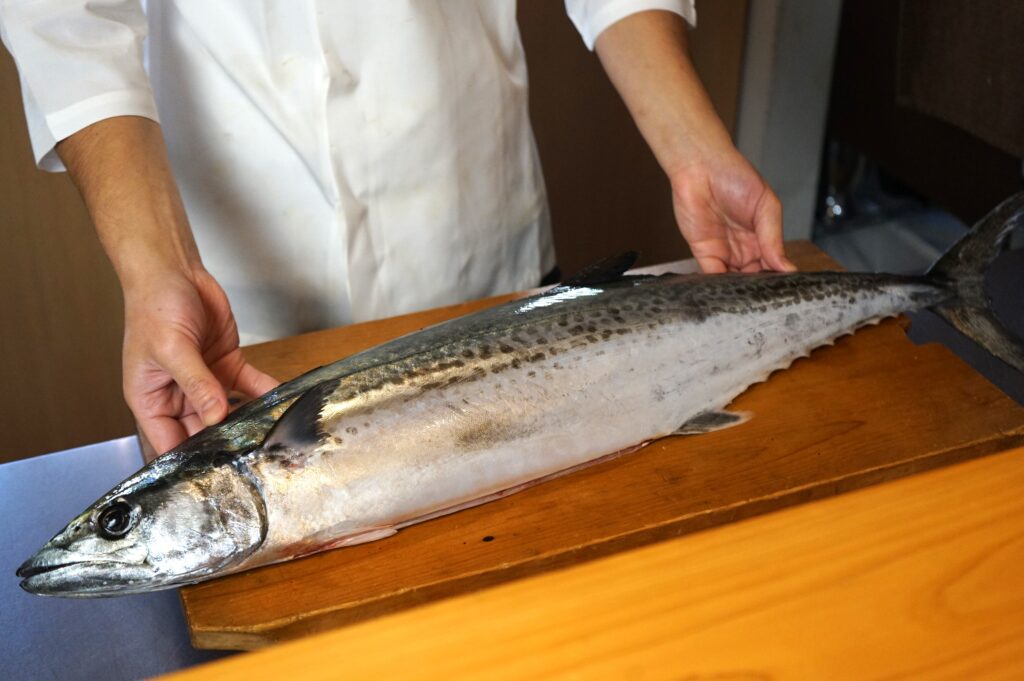
What You’ll Learn in This Article:
- What “shun” means in Japanese culinary culture
- Why Japanese chefs prioritize seasonal ingredients in every dish
- How “shun” connects nature, tradition, and flavor in kaiseki cuisine
- Examples of spring, summer, autumn, and winter ingredients used at Ise Sueyoshi
- How Ise Sueyoshi designs each course to highlight seasonal transitions
Japan Is Made of Seasons
To journey through Japan is to surrender yourself to the stories of the seasons.
When visiting this country, one must first understand the depth behind the word kisetsu—“season.” Japan has four distinct seasons: spring brings blooming cherry blossoms, summer is filled with festivals and ocean delicacies, autumn glows with crimson leaves and harvest flavors, and winter welcomes travelers with snowy landscapes and the warmth of hot pots. But to the Japanese, “season” is far more than just the passage of spring, summer, fall, and winter.
Since ancient times, the Japanese have marked the year using the 24 solar terms (二十四節気, nijūshi sekki), such as Risshun (start of spring) and Rittō (start of winter). Though this calendar originates from Chinese agricultural traditions, it has taken root in Japan’s own climate and customs, influencing not just farming, but cuisine and daily life as well. Even more refined is the concept of 72 micro-seasons (七十二候, shichijūni kō)—brief five-day intervals with poetic names like “The First Haze Appears” or “Frogs Begin to Sing.” These expressions of nature’s subtle changes reflect the Japanese reverence for the natural world and their deep sense of beauty.
Such sensitivity stems from spiritual traditions like Shinto and Buddhism, which emphasize harmony with nature, as well as from centuries of agrarian living. In Japan, seasons are not just changes in climate—they are rhythms that guide life itself.
For travelers, embracing this uniquely Japanese sense of seasonality can unlock a deeper experience. The landscapes and flavors you encounter will vary completely depending on the time of year. From spring cherry blossoms to autumn leaves, from snowy winter scenes to the fleeting tastes of seasonal ingredients—each moment offers an unrepeatable memory, etched into the heart of your journey.

Nature on Plate
In Japan, the breath of the four seasons is quietly woven into every dish.
Japanese cuisine is more than just food—it is an art form that captures the essence of nature on a single plate. Mountains, rivers, seas, and even the breeze and sunlight are gently reimagined by the hands of the chef. At the heart of this lies the Japanese spirit of living in harmony with nature.
In spring, you’ll find tara no me (angelica sprouts) and fukinoto (butterbur buds) emerging like the first signs of life after the snow has melted. Served alongside cherry blossom sea bream and rapeseed flowers, the plate resembles a walk along a mountain stream at the beginning of spring.
Summer brings vibrant tomatoes and eggplants, joined by ocean delicacies like abalone and pike conger. A “hiyashi-bachi” dish—served in a bowl over ice—offers a cooling visual and sensory retreat from Japan’s humid summer.
Autumn highlights wild mushrooms, freshly harvested rice, rich bonito, chestnuts, and ginkgo nuts—ingredients full of seasonal bounty. With colorful garnishes mimicking autumn leaves, the dish becomes an edible momijigari—a journey to admire the fall foliage through taste.
And in winter, luxurious ingredients like spiny lobster and pufferfish are paired with gentle flavors of turnip and yuzu. Together, they evoke both the silence and warmth found in the heart of the cold season.
Even the vessels used in Japanese cuisine are considered part of nature. In spring, dishes may be adorned with bamboo or cherry leaves; in autumn, fallen leaves and acorns; and in winter, snowflake patterns and rustic earthenware. Each element is designed to let you feel the wind of the season with your eyes as well as your taste.
This philosophy of “eating a landscape” reflects deep respect for nature. Every decision—from what to serve, to how it’s arranged—is a quiet dialogue with the natural world. Japanese cuisine, at its essence, is a celebration of the seasons unfolding on a single plate.
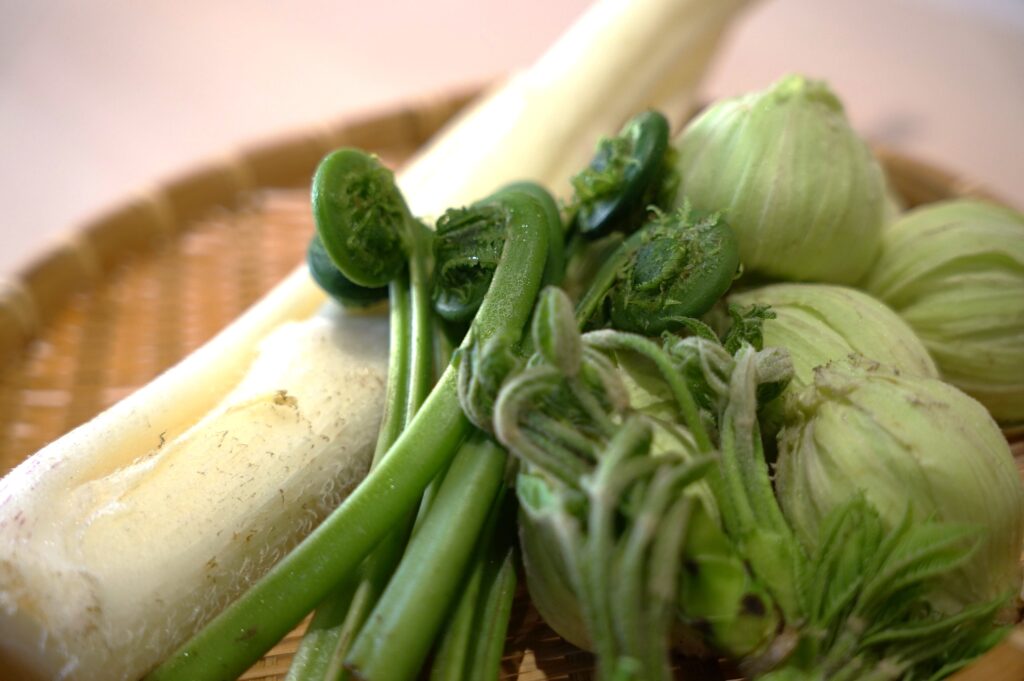
Seasonal Ingredients
In Japan, the moment when an ingredient shines the brightest is called “shun”—its true season. It’s not just about freshness; it’s about a fleeting fragrance, a depth of flavor, and a presence that can only be found during a specific time of year.
The true essence of Japanese cuisine lies in its delicate appreciation of seasonality. And “shun” is not a single point in time—it is understood in three distinct phases: hashiri (early season), shun (peak season), and nagori (late season).
- Hashiri is the early arrival of a seasonal ingredient, offering fresh, young flavors with lively acidity and aroma.
- Shun is the height of ripeness, when sweetness, umami, and fragrance are at their fullest—when the ingredient is at its most expressive.
- Nagori, or the lingering end, brings deeper, mellow flavors with a nostalgic, almost wistful finish.
Dishes that combine hashiri and nagori, or shun, are known as “deaimono”—literally, a seasonal “encounter” born from uniquely Japanese sensitivity. In spring, for example, young bamboo shoots from the mountains are simmered with tender wakame seaweed from the ocean—“the mountain spring meets the sea spring” on a single plate. In autumn, fatty pike conger in its nagori phase pairs with aromatic hashiri matsutake mushrooms—a once-in-a-season collaboration of richness and fragrance.
For chefs, the ability to discern the precise moment of shun is the ultimate skill. Even the same bamboo shoot can differ slightly in aroma or moisture content from year to year. It takes a trained eye—and heart—to recognize the condition of each ingredient that very day, and to select the cooking method and pairing that will bring out its best. Kaiseki cuisine is built upon this fine-tuned craftsmanship.
Japanese cuisine also weaves together ingredients from the mountains and the sea, creating a dynamic portrait of the four seasons. Spring’s thaw, summer’s humidity, autumn’s harvest, and winter’s cold—each season’s mood is expressed through taste, aroma, and texture, carefully plated for the senses.
For travelers visiting Japan, each dish becomes a reflection of nature in that very moment—a landscape you can taste. No two experiences are ever the same. To savor this fleeting, seasonal beauty is a uniquely Japanese luxury—one you’ll remember long after the journey ends.

Bamboo Shoots & Kaiseki: Savor the Essence of Spring in Tokyo, Roppongi’s Hidden Gem |
Savor the Season: Experience Japan through Autumn Kaiseki |
Why Kaiseki Matters
Kaiseki is more than a meal—it is one of the most poetic ways to express the changing seasons through Japanese cuisine.
It is a cultural experience that gently transforms nature’s fleeting beauty into dishes that speak to both the senses and the spirit.
The roots of kaiseki lie in the world of tea. Originally created as a light meal to accompany the tea ceremony, it follows the classic “ichiju-sansai” style—one soup and three dishes—crafted with precision, harmony, and grace. Every element, from the timing of the service to the subtle pauses between courses, is carefully composed. Kaiseki embodies the spirit of “knowing sufficiency”, valuing quiet elegance over extravagance.
In the hassun course, a selection of seasonal appetizers is artfully arranged to resemble a miniature landscape. In nimono (simmered dishes), the interplay of ingredients and cooking techniques draws out the essence of that moment’s shun, or seasonal peak. Yakimono (grilled items) bring out smoky depth and strength, while clear soups capture the fleeting fragrance of the season in a single sip.
The essence of kaiseki lies not only in taste, but in how it engages all five senses—and perhaps even a “sixth sense”: the subtle appreciation of stillness, timing, and atmosphere. From the harmony of colors between dish and vessel to the serene rhythm of the dining space, every detail is designed as part of an immersive experience in Japanese hospitality.
For those who wish to truly understand the beauty of “wa”, or Japanese aesthetics, kaiseki offers a rare and profound insight.
Each course whispers a message from the season—an ephemeral story told through flavor, form, and feeling.
In these quiet moments, one can experience the spiritual heart of Japan in its most refined and intimate form.
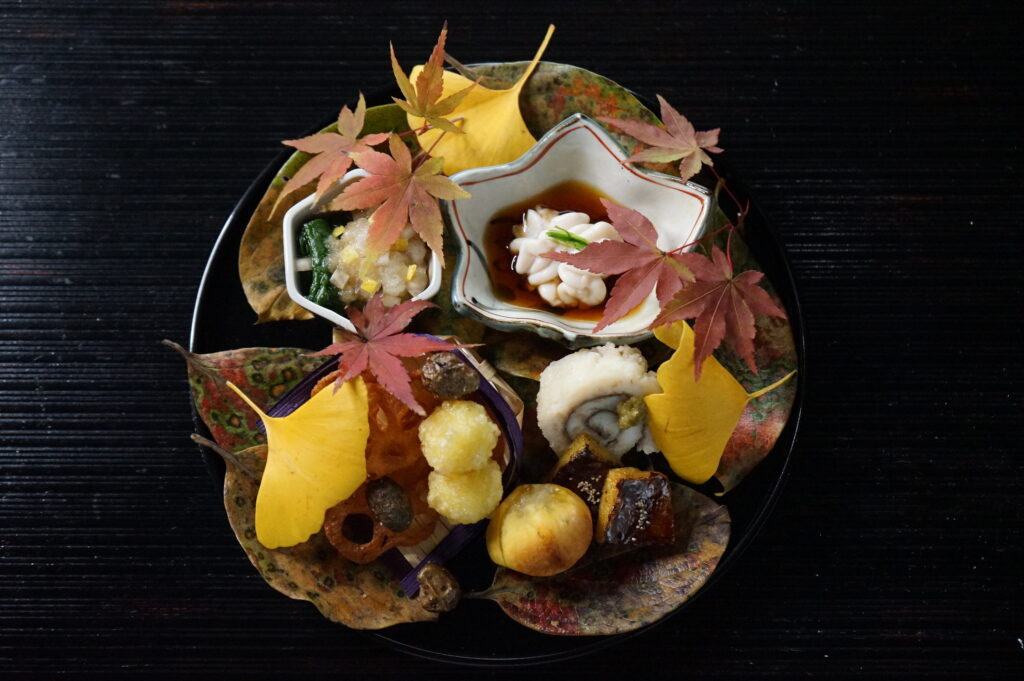
Kaiseki Explained
Kaiseki cuisine finds its origins in “cha-kaiseki”, a modest meal served before the tea ceremony. Rooted in Zen philosophy, it was originally designed to gently warm the stomach and prepare the palate for the subtle flavors of tea—a humble and thoughtful expression of hospitality.
Over time, this tradition evolved into the highly refined experience we now call kaiseki. No longer simply a meal, it has become a multi-sensory art form. Each element—seasonal ingredients, ceramics, plating, fragrance, ambiance, and the pacing of time—works in harmony like a carefully choreographed performance.
In kaiseki, even the order and timing of each course, the spacing of conversation, and the pauses between servings are part of the experience. A full kaiseki course is a journey through the seasons, inviting the guest to explore the deep and subtle rhythms of Japanese culture through food.
It is not merely about eating—it is about feeling, listening, and seeing. Kaiseki is an immersive cultural encounter, a refined form of Japanese entertainment that speaks not only to the five senses, but to the heart.
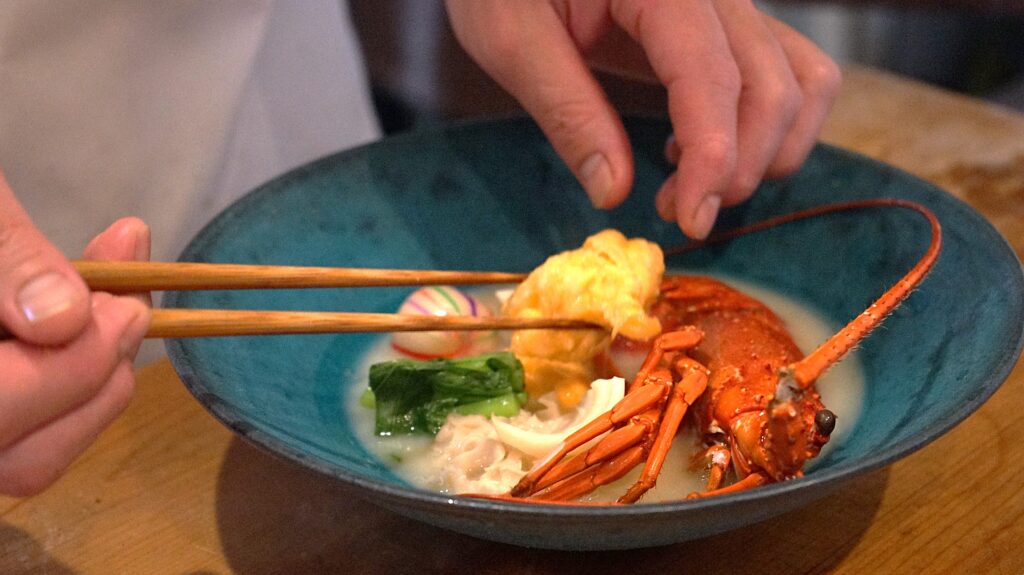
Read more: What is Kaiseki cuisine?
Taste of Tokyo
In the heart of Tokyo, quietly nestled on the third floor of a modest building between the vibrant neighborhoods of Roppongi and Hiroo, lies Ise Sueyoshi. With just ten seats, this intimate kaiseki restaurant offers a truly exclusive experience. Reservations are essential, and every guest begins their meal at the same time—an omakase journey that unfolds like a seasonal story, unique to that moment.
Step inside, and the bustle of the city melts away. A serene space inspired by traditional Japanese aesthetics awaits you. The restaurant features a five-seat counter that feels as if it were prepared just for you, and a single private room. Every detail—from the seasonal decorations and fresh flower arrangements to the choice of tableware and handwritten menus—reflects “Japan in this very moment.”
At Ise Sueyoshi, we serve authentic seasonal kaiseki using Japan’s finest ingredients. For example:
- Ise ebi (spiny lobster) from the seas of Mie Prefecture is prized for its tender texture and natural sweetness.
- Awabi (abalone), gently cooked, offers a deep aroma and silky softness.
- Wagyu beef melts in your mouth, leaving a rich umami flavor.
- In addition, guests can savor rare natural fugu (pufferfish), expertly prepared, or indulge in maguro (tuna) dishes that highlight the peak of the season.
For many international guests, Ise Sueyoshi becomes the perfect destination for the final night of their journey in Japan—a place to experience the authenticity of true Japanese hospitality. Whether marking a special occasion or sharing a romantic evening, the experience leaves a lasting impression: a night that nourishes not only the body, but the heart.
Though located in the middle of the metropolis, Ise Sueyoshi offers a rare opportunity to feel the seasons through all five senses. A quiet sanctuary away from the urban rush, it is a space where the essence of Japanese culture is carefully preserved—a hidden world within Tokyo itself. It is in this unique environment that one can truly savor the fleeting beauty of seasonal flavors.

Read More about fugu (pufferfish)
Read More about Ise Ebi Lobster
Meet the Chef
At the heart of this one-of-a-kind space, it is one chef’s unwavering sensitivity and belief that elevate the concept of “seasonality” into a narrative.
Yuuki Tanaka, the executive chef and owner of Ise Sueyoshi, is a culinary artisan who ventures to mountains, seas, and farms across Japan to connect directly with producers. Every morning, he exchanges messages with fishermen, farmers, and foragers to check details such as the fat content of fish, the fragrance and moisture levels of vegetables, and the overall condition of ingredients. Based on this dialogue, he assembles each day’s menu by selecting combinations that best express the current moment of seasonality.
At the core of Chef Yuuki’s philosophy is the idea of “circulation of the heart.” For him, cooking is not merely a technical act—it is the art of translating the life of nature and the heartfelt devotion of producers into a dish. By presenting these dishes to his guests, and in turn, conveying their appreciation and emotional response back to the producers, he aims to create a continuous, heartfelt cycle of connection.
One of the most distinctive expressions of this philosophy is the “Producers’ Encyclopedia,” a unique initiative exclusive to Ise Sueyoshi. Only three copies exist in the world. Within its pages are portraits, personal stories, and philosophies of the restaurant’s partner fishermen, farmers, and hunters. As each course is served, staff members open this book and share the background and spirit behind the ingredients with the guests.
The cuisine at Ise Sueyoshi is far more than just a taste of the season. It is the embodiment of human connection and the expression of a fleeting moment. Each dish, born from Chef Yuuki’s trusted relationships and real-time conversations, becomes a memorable and meaningful experience for every guest who visits.
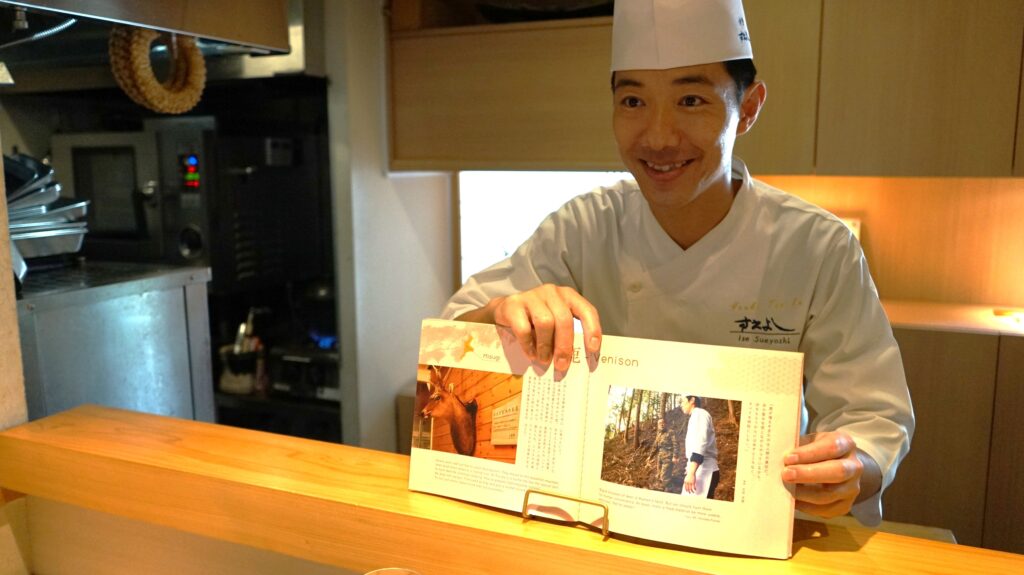
Read More about Chef Yuuki
The Story of Tokyo’s Best Chef, Yuuki Tanaka: Bringing the Blessings of His Hometown to the World
Vegetables in Season
Japan’s distinct four seasons bring out the diverse expressions of vegetables throughout the year. In spring, bamboo shoots and mountain vegetables like fiddlehead ferns, udo, and tara-no-me (angelica sprouts) symbolize the awakening of life. Summer offers juicy tomatoes, eggplants, and cooling winter melon. Autumn is the season of abundance, with chestnuts, pumpkins, wild mushrooms, and ginkgo nuts. Winter features nourishing root vegetables such as turnips, napa cabbage, and yams, along with mineral-rich seaweed—ingredients that warm the body from within.
In kaiseki cuisine, these seasonal vegetables are far more than mere side dishes—they often take center stage. Without the use of meat or fish, their natural umami and aroma are fully brought to life through traditional Japanese techniques such as simmering, grilling, steaming, and marinating. Each dish offers a quiet, refined delight—a celebration of nature’s subtleties.
At Ise Sueyoshi, we offer a dedicated vegetarian and vegan course that excludes all animal-based ingredients. Yet, even without them, the refined skills of Japanese cuisine create dishes that resonate deeply with all five senses—taste, aroma, texture, visual beauty, and temperature. It is a tranquil and luxurious experience, akin to tracing the shifting scenery of the seasons through your senses.
Vegetables carry with them the memory of the soil, water, and climate from which they were born. They are indispensable to telling the story of seasonality in Japan. As each season brings forth a new expression, guests will always encounter something fresh and unexpected—no matter how many times they return.
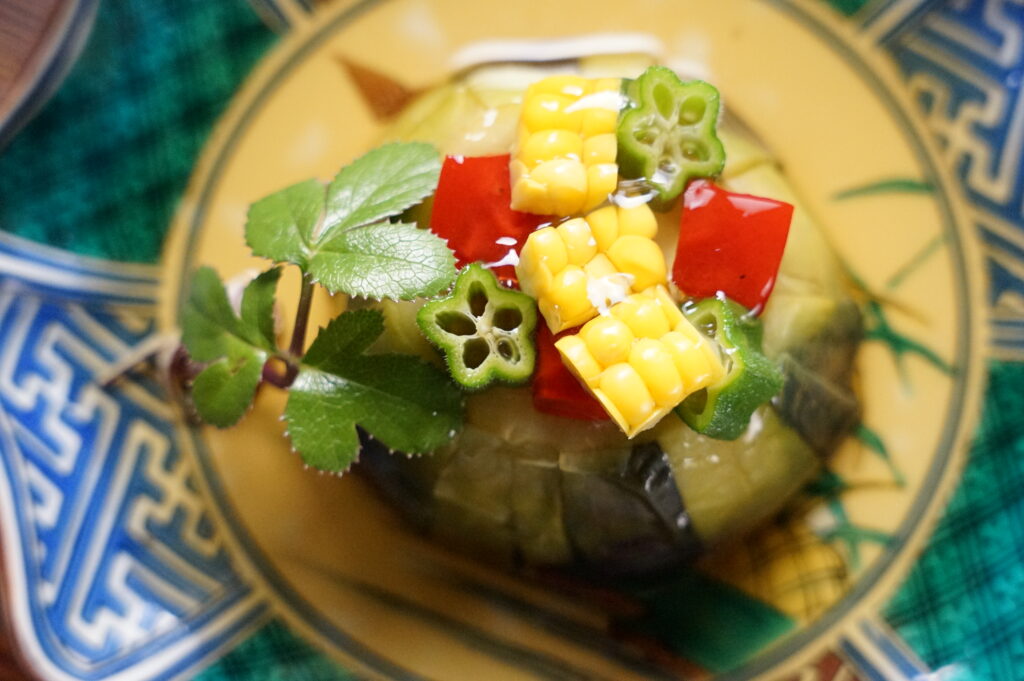
For more about our vegan or vegetarian philosophy please visit this page.
Gluten-Free Experience
For those with gluten allergies or who follow a gluten-free diet, dining while traveling can often come with a sense of unease. At Ise Sueyoshi, we understand these concerns and are pleased to offer a carefully crafted gluten-free kaiseki course upon request.
While Japanese cuisine is often associated with soy sauce—a condiment that typically contains wheat—its flavor foundation is far more diverse. From rice, kelp, and bonito flakes to miso, vinegar, and koji, the cuisine draws upon a wide range of fermented and umami-rich ingredients. Today, high-quality gluten-free soy sauces are also becoming increasingly available, allowing us to maintain depth and harmony of flavor without compromising dietary needs.
Even without wheat-based elements, the artistry of Japanese culinary tradition allows for the full expression of seasonal ingredients, ensuring every dish remains elegant, satisfying, and true to its roots. In fact, many gluten-free guests from around the world have described their experience at Ise Sueyoshi as “the most delicious Japanese meal of my life.”
At Ise Sueyoshi, dietary restrictions are not seen as limitations, but as an opportunity to showcase the precision and care that define Japanese craftsmanship. We invite you to discover a kaiseki experience where both your needs and your senses are honored with the utmost respect.
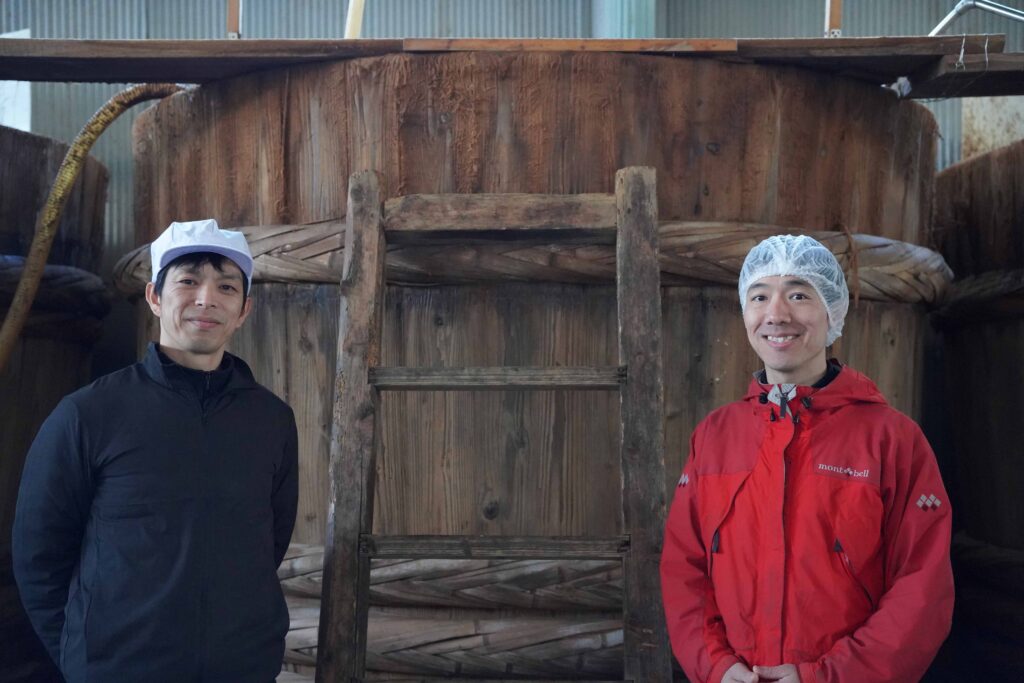
For more about our gluten-free please visit this page.
Seasonal Pairings
At Ise Sueyoshi, many of our guests look forward to the experience of pairing seasonal Japanese sake with each course of their kaiseki meal. Our sake pairing is not simply a list of beverages—it is thoughtfully curated to walk in step with the meal, designed around the harmony of aroma, flavor, and lingering finish.
For example, in early summer, a clear soup may be accompanied by Zaku, a refined sake from Mie Prefecture. Its crisp, transparent aroma mirrors the delicate fragrance of fresh wakame seaweed and green yuzu, allowing diners to sense the season with every sip.
The sakes we serve change with the seasons, featuring labels and flavor profiles that reflect the time of year. From the elegance of a junmai daiginjo to the richness of a matured sake, each selection is presented in rhythm with the progression of the meal—creating a sensory journey that evolves course by course.
We also carefully choose sake vessels to match both the sake and the season. Delicate cut glass and tin are used for chilled sake, while warm sake is served in ceramics or Bizen ware—offering not just taste but a full five-senses experience.
Even guests unfamiliar with sake are warmly welcomed. Each pour is accompanied by a gentle explanation to ensure an enjoyable and approachable experience.
We invite you to discover the seasonal harmony between food and sake—an encounter that resonates beyond taste alone.
Read more about Sake Pairing:
Enhance Your Kaiseki Experience in Tokyo: Sake Pairing for Ultimate Satisfaction
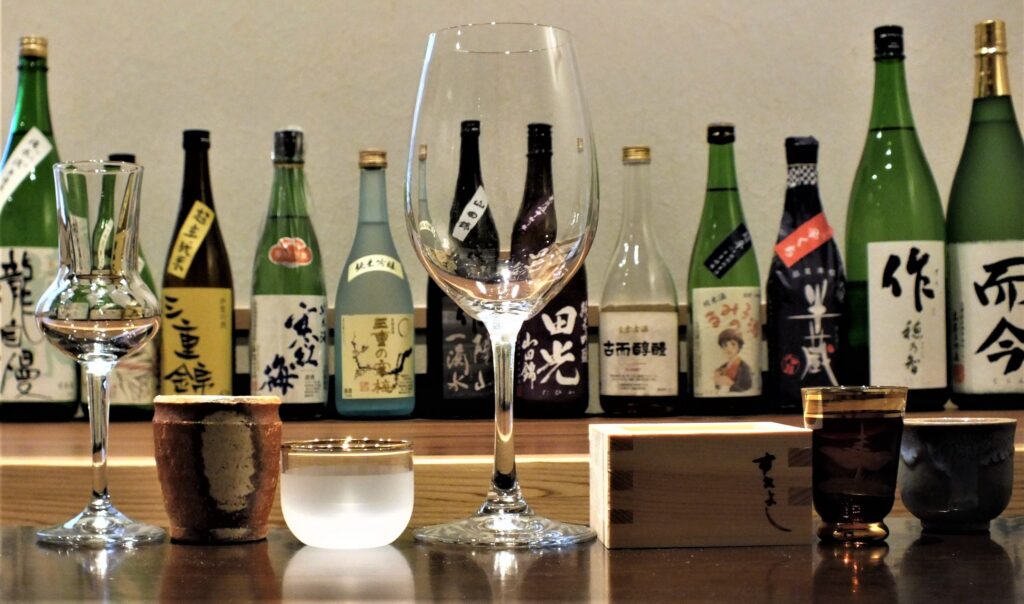
Plan Your Journey
There’s a reason why many international guests choose to spend their “final night in Japan” or celebrate “special milestones” at Ise Sueyoshi. Tucked away in a quiet residential neighborhood between Roppongi and Hiroo, our intimate space offers a peaceful setting—an ideal place to quietly reflect on the emotions and memories of your journey, away from the bustle of Tokyo.
Whether it’s a honeymoon, birthday celebration, or a heartfelt gift dinner, Ise Sueyoshi has welcomed guests marking life’s most meaningful moments.
For those seeking an authentic and moving experience of Japan through the art of kaiseki cuisine, every element—from the seasonal ingredients and handcrafted tableware to the carefully curated ambiance—tells a story rooted in the present moment.
May your final taste of Japan become a cherished memory, enriched by the spirit of the season and the fleeting beauty of now.
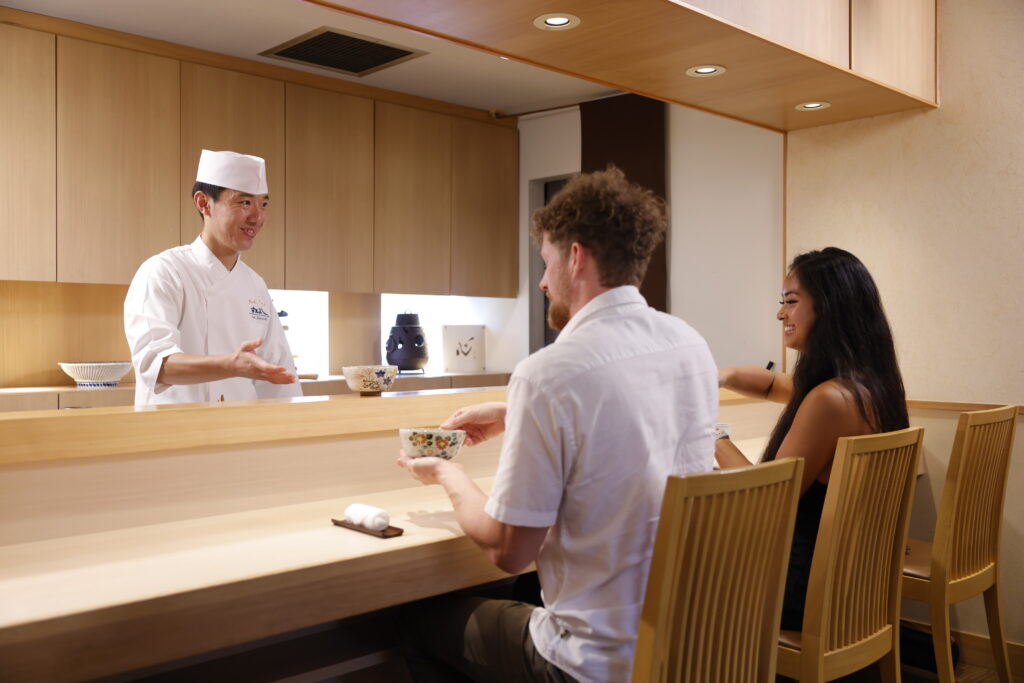
Many choose Ise Sueyoshi as a gift dinner for birthdays or honeymoons.
Learn more this article.
Our Guest’s Voice
Life Changing Meal – You Must Eat Here Once In Your Life!!!!
May 2025
I will remember this as the best meal of my life, and this is the only place that I will visit time and time again every time I go back to Japan. I found out about this restaurant on an itinerary I made back in 2021 with my late brother, and he wrote down, “Ise Sueyoshi – Kaiseki/kappo shop” with no further information. Since it was my first time in Japan with siblings and friends this year, I looked up this restaurant a few months prior to my arrival and decided to book a remembrance celebration dinner at the counter at 5pm. It was an intimate experience with another couple present. We took a minute to find the building as I wasn’t aware of the area or the signs, but were promptly greeted by Yuuki and his staff. He welcomed us with a sake and told us about the menu. He explained that he is a second generation chef and following in his father’s legacy by opening a restaurant in Tokyo. Every dish he cooked and presented to us felt like a story of Japan. He will cook, and explain to you (in english) about the dish. It’s something you have to experience for yourself. The produce, meat, vegetables, and ingredients are carefully selected and Chef Yuuki is an expert of cooking it in the best way possible to reflect the seasons. He is knowledgable and brings out the best of all the flavors. I opted to try a sake pairing and was amazed to see how the flavors complemented the food so well. It leaves an impression that follows me to this day. I can close my eyes and think about food so delicious and a memory so precious that I will not hesitate to come here again, and again. I did not opt for any changes or requests in the menu prior to eating here, but I made a note that my friend was vegetarian. This is amazing that a restaurant of this caliber and sophistication is so accommodating to all dietary restrictions, and preferences. Anyone can eat here – he will make you feel welcome all the time! Overall – this is a restaurant and experience mixed into a night you will remember. You can really feel the love that Chef Yuuki puts into every dish he makes – it’s a passion that is rare and amazing to see in person. I hope that you will come and enjoy it as much as me and my friends did. Thank you so much for having us and I hope to eat here again as soon as I can come back to Japan.
We are proud to continue delivering an exceptional dining experience that earned us the Tripadvisor Travelers’ Choice Best of the Best 2024 award, ranking among the Best Restaurants in Tokyo. Our commitment to excellence in service and our dedication to offering the finest kaiseki dining experience in Tokyo remain unwavering. Discover more about our journey to becoming one of the best restaurants in the city[here].

Visit Ise Sueyoshi
Location: Conveniently located 12 minutes from Roppongi Station and 8 minutes from Hiroo Station.
Hours: Open 5:00 PM – 10:00 PM, reservations only. Closed on Sundays and Mondays.
Book Your Experience ☟
Reservation Information
In response to many requests from our guests, Ise Sueyoshi now accepts reservations up to 180 days in advance of your preferred dining date.
With only 10 seats available, we are committed to providing a smooth and personalized reservation experience.
To ensure you don’t miss the opportunity to celebrate your important anniversaries or special occasions with us, we highly recommend making your reservation as soon as your plans are set.
If you are planning a trip to Japan, we warmly invite you to include a special moment at Ise Sueyoshi in your itinerary.
Many of our guests also choose us for their final evening in Japan, as a beautiful and memorable way to conclude their journey.
Please note that our reservation policies may change without prior notice. For the latest updates, please refer to our reservation page.
Conclusion
At Ise Sueyoshi, we humbly invite you to experience a dining journey that caters to all dietary needs. Whether you’re vegan, halal, or have specific preferences, we are here to create a memorable and inclusive dining experience for you, especially for special occasions like a honeymoon.
Recommended Blog Posts
On our blog, we offer further insights into Tokyo’s rich food culture and the unique culinary experiences we provide at Ise Sueyoshi. Be sure to check out these recommended posts:
Where Fireworks Meet Tokyo Kaiseki: A Summer Night of Elegance |
Why You Must Try Kaiseki Cuisine in Tokyo: A Unique Experience of Culinary Art and Intellectual Delight |
@isesueyoshi
o 🏆 Awarded the prestigious Best Luxury Restaurant by TripAdvisor
o 🌍 Ranked 2nd worldwide, 1st in Japan, and 1st in Asia
o ⭐ Google rating of 4.9 (as of 2024)
o ✅ Vegan-friendly
o ✅ Halal selections
o ✅ Gluten-free options
o ✅ Vegetarian delights
o ✅ Pork-free choices
o ✅ Perfect for pescatarians
o 🌈 Welcoming and inclusive environment for LGBTQ guests
o 🚃 Just a 12-minute walk from Roppongi Station or 8-minutes from Hiroo Station
o ⏰ 5:00 PM – 10:00 PM (reservations-only)
o 📅 Closed on Sun and Mon
